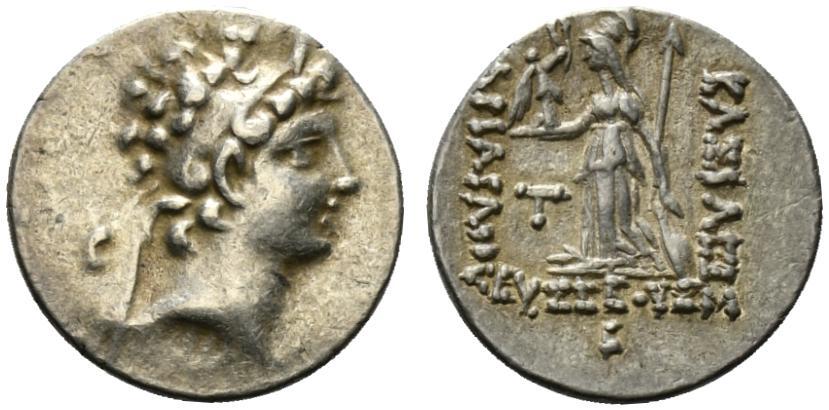Eusebeia (Ariarathes VIII), silver, drachms (Ariarathes VIII/Athena nicephorus) (100-97 BCE)
From SILVER
100 BCE - 97 BCE Silver 3,774 kg
Description
| ObverseInscription or printing placed on the obverse.: | Diademed head r. |
| ReverseInscription or printing placed on the reverse.: | ΒΑΣΙΛΕΩΣ ΑΡΙΑΡΑΤΟΥ ΕΥΣΕΒΟΥΣ ou ΕΠΙΦΑΝΟΥΣ (Greek).Athena Nikephoros standing l., T to inner l., Δ ? (date) in exergue |
Mint and issuing power
| MintIdentifies the place of manufacture or issue of a numismatic object.: | Eusebeia | Ancient regionAncient region.: | Cappadocia | Modern countryModern country: Turkey | AuthorityIdentifies the issuing power. The authority can be "pretended" when the name or the portrait of X is on the coin but he/she was not the issuing power. It can also be "uncertain" when there is no mention of X on the coin but he/she was the issuing power according to the historical sources: | Ariarathes VIII Eusebes Epiphanes (king of Cappadocia, c. 100-c. 95 BC), Cappadocian kingdom |
Chronology
| FromIdentifies the initial date in a range assigned in a numismatic context. | 100 BCE | toIdentifies the final date in a range assigned in a numismatic context.. | 97 BCE | PeriodTime period of the numismatic object.: Hellenistic 323-30 BC |
Physical description
| MetalThe physical material (usually metal) from which an object is made.: | Silver |
Median weightMedian of the weights of numismatic objects (in grams). in grams | 4.10 | DenominationTerm indicating the value of a numismatic object. Examples: tetradrachm, chalkous, denarius.: | drachma |
StandardStandard.: | Attic |
Image

H270 Eusebeia Ariarathes VIII.jpg [1]
References
| Die study referencePublication of the study: | Mørkholm 19681Mørkholm 1968 | ||
| Coin series referenceReference to coin series study: | Sear II2Sear II, n° 7293-7294, RQEMH3RQEMH, n° 270, HGC 74HGC 7, n° 835 | ||
Obverse dies distribution
| FrequencyFrequency of specimen in distribution. ᵖ | Number of obversesNumber of obverse dies. ᵖ (o) | % (o) | Number of coinsNumber of coins. (n) | % (n) | Die nameName(s) of the die(s). |
| 1 | 11 | 30.56 | 11 | 10.28 | 8, 12, 19, 20, 21, 23, 24, B4, B5, B8, B12 |
| 2 | 8 | 22.22 | 16 | 14.95 | 5, 6, 11, 16, 17, B2, B7, B10 |
| 3 | 7 | 19.44 | 21 | 19.63 | 4, 7, 9, 13, 15, 18, B11 |
| 4 | 2 | 5.56 | 8 | 7.48 | 14, B3 |
| 5 | 4 | 11.11 | 20 | 18.69 | 2, 10, 22, B1 |
| 6 | 1 | 2.78 | 6 | 5.61 | 3 |
| 7 | 1 | 2.78 | 7 | 6.54 | B9 |
| 8 | 1 | 2.78 | 8 | 7.48 | 1 |
| 10 | 1 | 2.78 | 10 | 9.35 | B6 |
| Total | 36 of 36 | 100.01 | 107 of 107 | 100.01 |
Reverse dies distribution
no distribution is available
Quantification
| Number of obversesNumber of obverse dies. ᵖ (o) | 36 | Number of singletons (o1)The number of singleton coins. ᵖ | 11 |
| Number of reverse diesNumber of reverse dies. (r) | 57 | Number of coinsNumber of coins. (n) | 107 |
| Coins per obverse dieNumber of coins per obverse die. (n/o) | 2.97 | Coins per reverse dieNumber of coins per reverse die. (n/r) | 1.88 |
| Reverse per obverse ratioRatio of obverse dies divided by reverse dies. (r/o) | 1.58 | Percentage of singletons (o1)number of coins (n) divided by the number of singletons (o1) ᵖ | 30.56 % |
| Original number of dies (O) (Carter 1983 formula)The estimation of the number of coins according to Carter 1983 ᵖ | 46.03 | Coins struck if 20,000 as average productivity per dieCoins made if the average productivity for obverses (according to Carter) is 20,000. ᵖ | 920,600 |
| Original number of dies (O) (Esty 2011 formula)The estimation of the number of coins according to the singleton formula in Esty 2011 ᵖ (O) | 54.25 | Survival rate if 20,000 as average productivity per dieSurvival rate if average productivity is 20,000. ᵖ | 0.00012 |
| Coverage (o = % of O) (Esty 1984 formula)Esty 1984 - coverage (% of O) ᵖ (o = % of O) | 89.72% | Die productivity if survival rate 1/2,000Average productivity if survival rate is 1/2,000. ᵖ | 4,649.14 |
| Weight of silver (in kg) if 20,000 coins per die (O = Carter formula)Carter 1983 * Median weight * 20000 (*10 if gold or electrum) ᵖ | 3,774 kg <br /> 3,774 kg | Die productivity if survival rate 1/5,000Average productivity if survival rate is 1/5,000. ᵖ | 11,622.85 |
Remarks
References
- ^ Mørkholm, Otto (1968), "The Coinages of Ariarathes VIII and Ariarathes IX of Cappadocia", in Essays Presented to Stanley Robinson, Oxford, p. 241-58, pl. 30-33.
- ^ Sear, David R. (1979), Greek coins and their values. Vol. II, Asia and North Africa, London, xlviii, p. 317-762
- ^ Callataÿ, François de (1997), Recueil quantitatif des émissions monétaires hellénistiques, Numismatique Romaine, Wetteren, X + 341 p.
- ^ Hoover, Oliver D. (2012), Handbook of Greek Coinages. 7. Coins of northern and Central Anatolia - Pontos, Paphlagonia, Bithynia, Phrygia, Galatia, lykaonia, and Kappadokia (with Kolchis and the Kimmerian bosporos), Lancaster, lxxxii, 352 p. : ill. ; 23 cm.